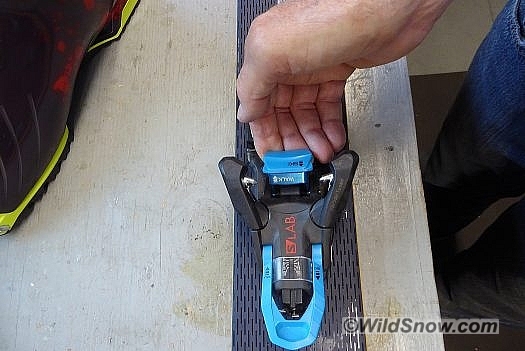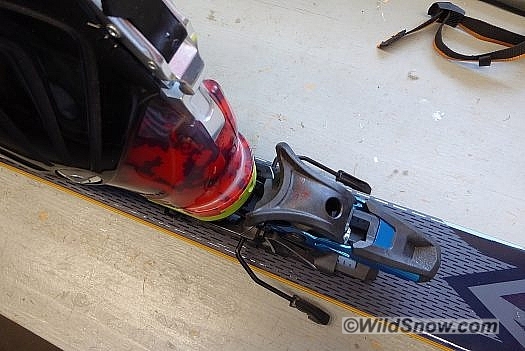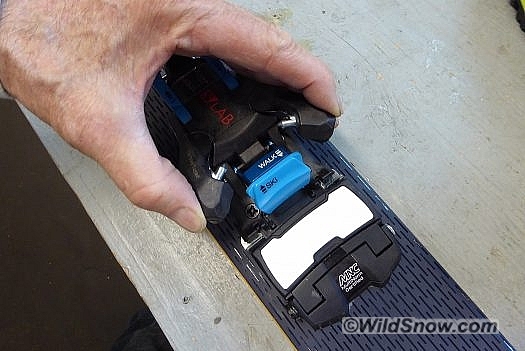
The object at hand. Game changer or ankle weight? Depends on your needs. Either way, bow before mechanical engineering excellence. (Click images to enlarge.)
While the Salomon Atomic SHIFT is a bit out of the WildSnow gamut for true ski touring bindings, it is so interesting I can not resist dissecting. We’ll have plenty of extended field tests as well, as we can’t let the other panting gear bloggers take it all! If you’ve been living inside a glacier, here is the elevator spiel:
An alpine binding TUV certified to DIN/ISO standard, with a clever hidden set of tech pins that when enabled allow you to ski tour, provided you have a boot with tech fittings as well as sole configuration that’s appropriate for using the Shift in alpine mode. Could be game changing for skiers who truly need a full alpine performance setup during their tours. For others it’s a yawner.
I’ve been privy to various efforts to develop this sort of binding. Doing so is not easy. You get into issues of how to provide heel lift in touring mode, how to lock the brake, how to stow the tech pins, weight; on and on. Follow along as we go through the SHIFT MNC.
While you don’t use the boot’s tech fittings for downhill skiing, as basis for comparison to other bindings (see our ramp and stack height chart), here are the numbers: While in alpine mode, the boot’s tech toe fittings are 37 mm above the ski, while imaginary tech pins are 46 mm above ski. (Bear in mind these measurements would vary with sole thickness, unlike true tech bindings that use the fittings to hold the boot in alpine mode.) Significant stack height (not the most we’ve seen, but up there at the top end of the spectrum), more or less zero ramp. Ramp (as I calculate) is exactly the same as a Salomon MTN tech touring binding.
Weight. This guy is light for what it is what am, though heavy for a touring binding: Heel 440 grams, Toe 444 grams, total 884 grams – 31 ounces (with screws). Many of you have spent years using bindings such as G3 ION and Dynafit Radical as hybrid resort/touring bindings — or more recently, the amazing Tecton. In that case you’re rocking around 600 grams per binding, around 300 grams less than SHIFT. That’s a noticeable difference that _will_ slow you down and make touring less comfortable. In that regard SHIFT is clearly not the holy grail (which would be a 550 gram binding that did the same thing), but it is a super cool and definitely useful tool for numerous applications. I’m thinking everything from the guy who’s mission in life is to use only one binding, all the way to stunt skiers who need alpine gear they can tour if the heli runs out of fuel or their producer runs out of cash.
No reason for me to duplicate content in terms of the ubiquitous how-to-use vid. Below is Atomic’s.

Going from downhill mode to touring. Just push the blue block of plastic, toe wings open up and expose the tech pins for your walking pleasure.

Ready to tour (as with most tech bindings, lock by pulling up the blue lever at the front, otherwise you’ll walk out of the binding).

You flip up the brake lock _before_ entering the binding. You can either lock the brake by hand, or step down on it with your boot.

You’ve climbed, now for the sweet descent on a full alpine binding. Brake easily unlocks when you gently press on the arms. I’m wondering if it unlocks too easily. Consumer testing commence.

Begin conversion to downhill mode by squeezing the toe wings together, which lifts the blue plastic tab you’ll need to get your fingers under.

Snap up the blue plastic block, doing final stowage of tech pins and converting the toe to a normal “toe wing” alpine binding. Next simply enter the binding as you would any conventional alpine binding: to in, then stomp down heel.

Boot length adjustment is fine tuned by lining the shiny metal up with the black arrows (click to enlarge, more obvious that way). Yes Virginia, this is a forward pressure setting! Finally, you can call the boot length adjustment FORWARD PRESSURE without getting scolded by me!

Nifty AFD height adjust for different boot soles cranks up and down with pozi or flat blade screwdriver. Crampon hook is visible, appears to accept “Dynafit” standard spikes but in reality will need something specific to work around the large AFD.
Compatibility:
Salomon uses the term MNC (multi norm compatible) to indicate the SHIFT functions with any DIN certified ski boot, touring or alpine. Further, it’s obvious the binding conforms to alpine DIN/ISO standards. We’re not clear if it’s also certified to the touring binding standard. The latter is not a concern. If it works for walking uphill, the overlap of the alpine standard with the touring standard takes care of verifying downhill performance (at least to the extent the standards do so, i.e., consumer testing is essential).
Conclusion:
If you need and alpine binding that tours, by all means! Otherwise, lighter options are better choices. Most importantly, SHIFT will help move the ski industry away from attempting to provide brutal alpine skiing performance from the tech pin system, which was never intended to accommodate the forces produced by large boots, big skis, and high speeds.
Salomon mini site, best viewed on 110-inch Ultra HDTV.
WildSnow.com publisher emeritus and founder Lou (Louis Dawson) has a 50+ years career in climbing, backcountry skiing and ski mountaineering. He was the first person in history to ski down all 54 Colorado 14,000-foot peaks, has authored numerous books about about backcountry skiing, and has skied from the summit of Denali in Alaska, North America’s highest mountain.







